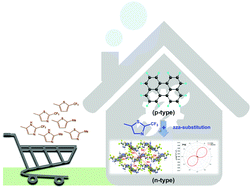Synergistic effects of side-functionalization and aza-substitution on the charge transport and optical properties of perylene-based organic materials: a DFT study†
Abstract
The physicochemical properties of organic materials are subject to the chemical structure of the molecular unit and the arrangement of molecules in a crystal. Herein, a series of perylene-based small-molecule organic semiconductors (OSCs) have been theoretically designed by subsequent functionalization of cyclic side chains and N-doping in perylene units. Different physicochemical properties of the designed molecules were explored using density functional theory. As a result of the synergistic effects of side-functionalization and aza-substitution in the parent perylene, a low-lying LUMO level (−3.926 eV) and high electron affinity (2.939 eV) have been achieved for the designed compound (P16), which are favourable for air-stable electron injection. The molecular packing motif and high intermolecular electron coupling in the P16 crystal led to enhanced electron mobility up to 0.017 cm2 V−1 s−1, making it a promising air-stable n-channel OSC. In addition, these perylene derivatives are also found to be optically active in the UV-visible region, which further experiences a bathochromic shift after substituting all peri-positions with the cyclic-substituents. The present study is therefore aimed at designing novel n-type and optically active small-molecule OSCs, which will be beneficial for several organic electronic devices.



 Please wait while we load your content...
Please wait while we load your content...